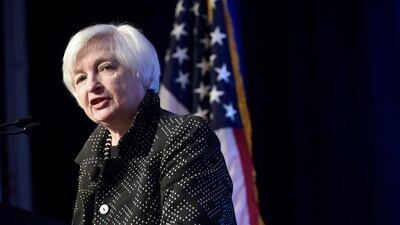This year started with the possibility of a rate increase by the US Federal Reserve and 12 months later we are still “potentially” on the verge of the hike happening. The Fed delayed the first hike, planned for January, until March, then June, September, October and now a decision is expected this month.
The Fed will consider many factors before making a decision, including growth, inflation and the labour market. At the start of the year the move to raise rates seemed absolutely certain. The previous October market conditions had improved enough to stop the quantitative easing programme, so continued growth would open up the way for the hike.
However, the US economy is a long way from its growth target of 2.5 per cent. But the headline figure does not tell the full story. All year the issue for the Fed has been that some of the data is good or on target, while other sets are well away from where they should be.
The labour market showed a notable improvement during the year, with the unemployment rate at 5 per cent, which is the lowest level since 2000. But there has been a recent period of slowing.
The latest economic releases, especially from the manufacturing sector, are more of a headache for the Fed. The ISM Manufacturing PMI unexpectedly shrank last month, posting the first contraction since 2012 and the worst reading since June 2009, declining to 48.6. This is also the fifth monthly decline in a row. New orders also contracted for the first time since November 2012, declining to 48.9, which is the lowest level since August 2012 at 52.9.
Looking at the Federal Reserve’s history, it has never increased rates when the ISM Manufacturing PMI is below 50. Through the current financial crisis, whenever the Fed stopped a QE programme the ISM Manufacturing PMI has weakened and then contracted. The decline in the ISM Manufacturing PMI started when the Fed stopped QE3 in October. So unless the central bank introduces another round of QE to get the ISM above 50 again, it looks as though it will have to start the tightening with the index below this magic figure. This will be a risk and could force the ISM even lower at a time when inflation remains way below the Federal Reserve’s target of 2 per cent.
After seven years of zero interest rates the Fed is under real pressure to bring in the rate increase, but as Janet Yellen, chairwoman of the Fed, has said it is unlikely that all the data would be in place to make the move. But this is not enough of a reason not to act.
So as we head to the next Federal Reserve meeting, on December 16, we believe that the Fed needs to raise rates, but it needs to find a way to weaken the dollar as quickly as possible. Can this be achieved – can there be a rate hike that is dovish for dollar?
Potential scenarios
There are a number of options for the hike that the Fed can look at. Some of these are as follows:
•Raising the Fed Funds Rate by 25 basis points, with promises that another hike will gradually introduce at the following Fed meetings. This would be very positive for the US dollar and negative for equities. Potential – low.
•Raising the Fed Funds Rate by 25bps, but introduce this as a test that would be evaluated over six to eight months before any further increases are introduced. This would be negative for the US dollar and positive for stocks, as the markets will take such a decision as a confident act. Potential – high.
•Keep the current policy and maintain the rhetoric that the hike will happen when the data has improved. However, this would harm the Fed’s credibility. Potential – medium.
It could all still change
After 11 months of debate and discussion the Fed is still looking at the current data releases. One of the most important is the US labour market. The economic updates right up to the day of the Fed’s meeting will be looked at in detail. Investors through the year have seen high levels of volatility as each potential date for the rate hike came and went. If the hike does happen the markets expect to see the dollar reach new highs and equities to fall back. But if the Fed opts for a limited hike with no further hikes planned for over six months, the dollar may spike and fall back, with equities maintaining their value.
Nour Eldeen Al Hammoury is the chief market strategist at ADS Securities
business@thenational.ae
Follow The National's Business section on Twitter

